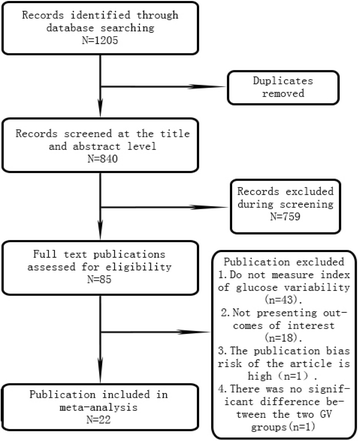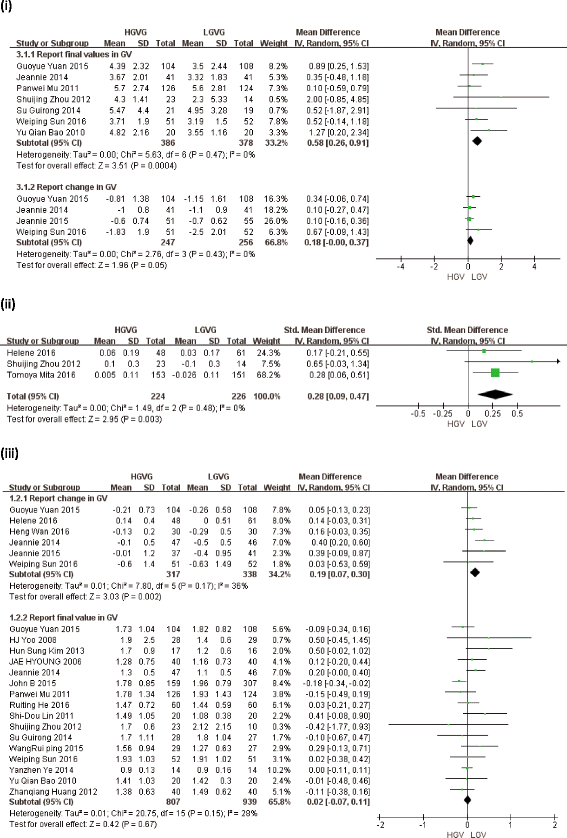Glucose variability for cardiovascular risk factors in type 2 diabetes: a meta-analysis
- PMID: 29164077
- PMCID: PMC5686902
- DOI: 10.1186/s40200-017-0323-5
Glucose variability for cardiovascular risk factors in type 2 diabetes: a meta-analysis
Abstract
Aims: It is consensus that glucose variability (GV) plays an important role in maccomplications of type 2 diabetes, but whether GV has a causal role is not yet clear for cardiovascular disease (CVD). This study sought to explore the effect on GV for CVD risk factors with type 2 diabetes.
Methods: The systematic literature search was performed to identify all GV and CVD risk factors, including total cholesterol (TC), LDL cholesterol (LDL-C), triglyceride (TG), HDL cholesterol (HDL-C), Body Mass Index (BMI), waist circumference (WC), High-Sensitivity C-reactive protein (Hs-CRP), Homeostasis model assessment (HOMA) and carotid intima-media thickness (IMT). Preferred Reporting Items was synthesized for Systematic reviews and Meta Analyses guideline. And the pooled analyses were undertaken using Review Manager 5.3.
Results: Twenty two studies were included with a total of 1143 patients in high glucose variability group (HGVG) and 1275 patients low glucose variability group (LGVG). Among these selected CVD risk factors, HOMA-IR and reduced IMT were affected by GV. HOMA-IR level was significantly lower in LGVG than in HGVG (MD = 0.58, 95% CI: 0.26 to 0.91, P = 0.0004), with evidence of heterogeneity between studies (I2 = 0%; P = 0.47).Reduced IMT level was significantly lower in LGVG than in HGVG (SMD = 0.28, 95% CI: 0.09 to 0.47, P = 0.003), with evidence of heterogeneity between studies (I2 = 0%; P = 0.48). However, the others were no significant statistical difference.
Conclusions: Among these selected CVD risk factors in type 2 diabetes, minimizing GV could improve insulin resistance and reduced IMT, consistent with a lowering in risk of CVD.
Conflict of interest statement
Ethics approval and consent to participate
Not applicable.
Consent for publication
Not applicable.
Competing interests
The authors declare that they have no competing interests.
Publisher’s Note
Springer Nature remains neutral with regard to jurisdictional claims in published maps and institutional affiliations.
Figures


Similar articles
-
Childhood obesity-related cardiovascular risk factors and carotid intima-media thickness.Turk J Pediatr. 2010 Nov-Dec;52(6):602-11. Turk J Pediatr. 2010. PMID: 21428192
-
Emerging risk factors as markers for carotid intima media thickness scores.J Am Coll Nutr. 2015;34(2):100-7. doi: 10.1080/07315724.2014.916238. Epub 2015 Mar 9. J Am Coll Nutr. 2015. PMID: 25751621
-
Associations between Fatness, Fitness, IGF and IMT among Obese Korean Male Adolescents.Diabetes Metab J. 2011 Dec;35(6):610-8. doi: 10.4093/dmj.2011.35.6.610. Epub 2011 Dec 26. Diabetes Metab J. 2011. PMID: 22247904 Free PMC article.
-
Dietary Total Antioxidant Capacity and Cardiovascular Disease Risk Factors: A Systematic Review of Observational Studies.J Am Coll Nutr. 2018 Aug;37(6):533-545. doi: 10.1080/07315724.2018.1441079. Epub 2018 May 1. J Am Coll Nutr. 2018. PMID: 29714643
-
The Effect of the Mediterranean Diet on Metabolic Health: A Systematic Review and Meta-Analysis of Controlled Trials in Adults.Nutrients. 2020 Oct 30;12(11):3342. doi: 10.3390/nu12113342. Nutrients. 2020. PMID: 33143083 Free PMC article.
Cited by
-
Personal and Social-Built Environmental Factors of Glucose Variability Among Multiethnic Groups of Adults With Type 2 Diabetes: Research Protocol Using Ecological Momentary Assessment, Continuous Glucose Monitoring, and Actigraphy.Res Nurs Health. 2024 Dec;47(6):608-619. doi: 10.1002/nur.22420. Epub 2024 Sep 7. Res Nurs Health. 2024. PMID: 39243147 Free PMC article.
-
Evaluating Glycemic Control During Basalin or Lantus Administration in Adults With Controlled Type 2 Diabetes Mellitus Using Continuous Glucose Monitoring.Front Endocrinol (Lausanne). 2021 Nov 30;12:754820. doi: 10.3389/fendo.2021.754820. eCollection 2021. Front Endocrinol (Lausanne). 2021. PMID: 34917025 Free PMC article. Clinical Trial.
-
Research progress on the association between glycemic variability index derived from CGM and cardiovascular disease complications.Acta Diabetol. 2024 Jun;61(6):679-692. doi: 10.1007/s00592-024-02241-0. Epub 2024 Mar 12. Acta Diabetol. 2024. PMID: 38467807 Review.
-
Recent Updates on Vascular Complications in Patients with Type 2 Diabetes Mellitus.Endocrinol Metab (Seoul). 2020 Jun;35(2):260-271. doi: 10.3803/EnM.2020.35.2.260. Epub 2020 Jun 24. Endocrinol Metab (Seoul). 2020. PMID: 32615710 Free PMC article. Review.
-
Perioperative glycemic control in patients undergoing cardiac surgery.Kardiochir Torakochirurgia Pol. 2025 Mar;22(1):44-52. doi: 10.5114/kitp.2025.148548. Epub 2025 Mar 17. Kardiochir Torakochirurgia Pol. 2025. PMID: 40290708 Free PMC article. Review.
References
-
- Buse JB, Ginsberg HN, Bakris GL, Clark NG, Costa F, Eckel R, Fonseca V, Gerstein HC, Grundy S, Nesto RW, et al. Primary prevention of cardiovascular diseases in people with diabetes mellitus - a scientific statement from the American Heart Association and the American Diabetes Association. Circulation. 2007;115(1):114–126. doi: 10.1161/CIRCULATIONAHA.106.179294. - DOI - PubMed
Publication types
LinkOut - more resources
Full Text Sources
Other Literature Sources
Research Materials
Miscellaneous

